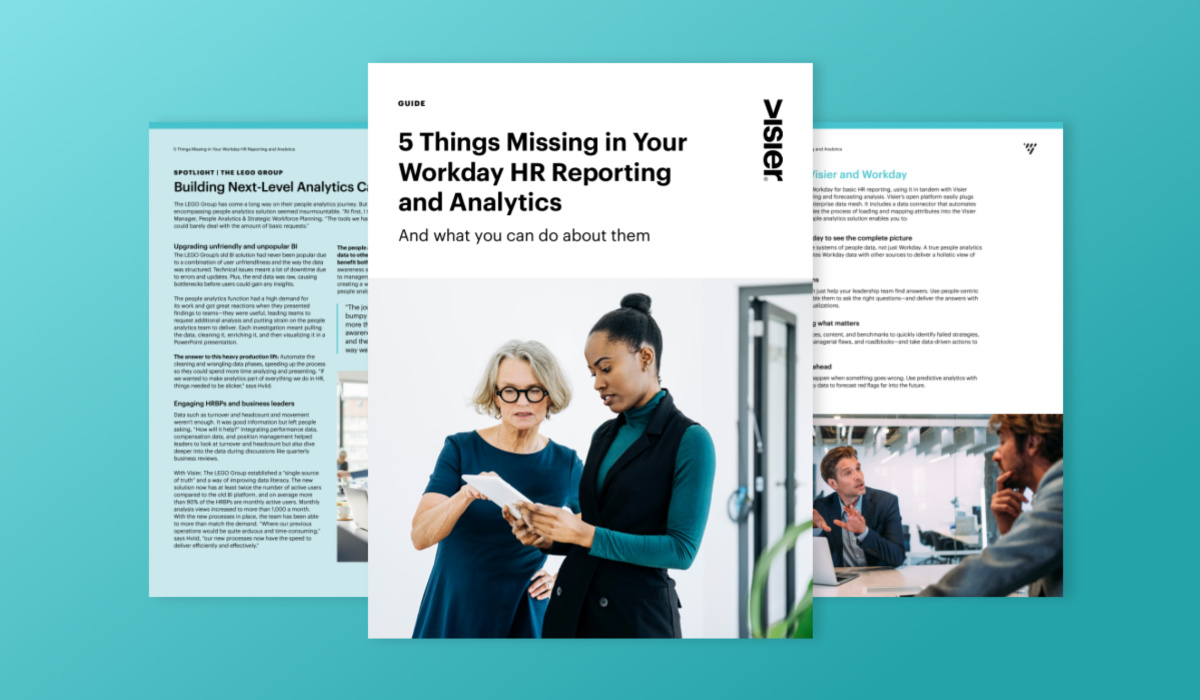
DATA MANAGEMENT
The Ins-and-Outs of Data Management: Definition, Importance, and Process
Data management enhances reliability, integrity, security, and scalability while addressing common challenges in HR. Learn about its crucial role and how to use it for the best results.
Start free trialTable of contents
What is data management?What is a data manager? Types of data managementWhy is data management important?4 data management challenges in HRHow to create a winning data management planTake control of your HR and people data with VisierWhat is data management?
Data management is the process of collecting, organizing, protecting, and storing data to use later for analytics.
Have you ever tried analyzing data only to realize you have no idea where it is all coming from and if it is up to date or accurate? With the growing number of data ecosystems, this is a more common scenario than you’d imagine.
Companies rely on data for most of their processes. For some, it’s the business itself. For others, it is a way to understand their workforce and improve productivity, performance, and retention.
Techniques like people analytics are invaluable tools for any company. Data management ensures data accuracy and security and will help improve governance and legal compliance.
What is a data manager?
A data manager is the person responsible for collecting, organizing, protecting, and storing data. They oversee all processes related to data management, ensuring data is always available, up-to-date, and accurate.
The data manager can also assist in the data analysis process, interacting with the HR team and other departments that actively use data for their day-to-day activities. They can help create reports and integrate HR systems with other databases to ensure a seamless flow of data.
Types of data management
Data management can play several roles in your organization. Here are some of the most important types and techniques to use.
Data preparation. Also known as data preprocessing, you’ll use this when you want to clean raw data and bring it all to a unified format you can later use for analytics.
ETLs (extract, transform, load). These are data management techniques that take data from one system or database, transform it, and load it into the new system.
Data pipelines. A pipeline is a path that data takes from one system to another. It allows automatic data transfers, minimizing the risk of data loss during the transfer.
Data catalogs. These are inventories of a company’s data. They help you manage metadata, summarizing all processing activities such as collection, transfers, and modifications.
Data governance. This includes creating standards, policies, and procedures to ensure data integrity and privacy. It is an essential data management step for regulatory compliance.
Data security. When working with personal data, ensuring its security is a must. This step includes establishing techniques to keep data secure from unauthorized access and is critical for data integrity, reliability, and regulatory compliance.
Data warehouses. Here, you’re aggregating and storing data from various sources in a centralized repository.

Why is data management important?
Without data management, processes like people analytics and using data to make informed decisions are almost impossible. Plus, the more data you acquire, the more difficult it becomes to keep it all secure, accessible, and up-to-date.
Before you know it, you’re using the wrong data for important business decisions, while security and compliance risks grow each day. With data management, you can avoid all these issues, and use your data in a smart, effective manner. Its benefits include:
Reliability. You can’t always avoid mistakes, but you can reduce their occurrence. Data management helps you keep your data up-to-date and establish policies and practices that increase reliability and reduce risk.
Integrity. Data integrity begins at the collection stage. That’s why you need to think of data management early on and minimize the risk of human or transfer errors that could compromise the consistency of your data.
Security. Data management is essential for security. It helps you implement security measures for your systems, minimizing the risk of a data breach.
Scalability. Data ecosystems are growing at an unprecedented pace. Data management allows you to scale your data while avoiding duplicates and keeping everything secure and up-to-date.

4 data management challenges in HR
Data management comes with immense benefits. But that doesn’t mean implementing it is without challenges. Here are some of the most common issues you’ll face.
The ever-increasing volume of data. Data growth is almost constant, and that’s a problem shared by HR and other similar departments. Market data, HR metrics, new and old employees, and potential candidates are only some sources that constantly provide new data. You need a data manager who is ready to tackle it all and systems that allow you to scale without a drop in performance.
Rapid changing privacy regulations. Data privacy has been a hot topic for several years now. The GDPR may have been the catalyst, but dozens of new regulations have appeared since. Keeping up can be a challenge, especially when working with personal or sensitive information.
Multiple analytics options. Analytics can help you understand your data and spot things that would be invisible otherwise. But there’s a wide variety of options out there, especially in HR. People analytics, predictive analytics, and augmented analytics are only some of your options. Each one can require a unique skill set and a different approach to working with data.
Rapid data conversion needs. To use your data effectively, you often need to have it all in a unified format. Raw data rarely comes in a unified format, though, especially when you acquire it from multiple sources.

How to create a winning data management plan
Creating a solid data management plan will help you maximize the impact of your data-driven efforts, helping to improve your talent acquisition, retention, engagement, and more. The exact steps you take will vary from business to business, but there are some best practices that will help you get started.
1. Set your business goals
Why do you want to implement data management? And how do you want to use your data? Determining your goals will help you find the best approach to collect, organize, process, and store data. It will also help you measure your progress as you go, so don’t forget to select measurable, realistic goals.
2. Identify data sources and types
Before you can begin working with your data, you must know what you’re collecting and from where. For HR, common sources will include candidate resumes, HR metrics, market research, performance reviews, and exit interviews. Look back at your goals to see exactly which data you need and which type.
3. Select the team
Who will have access to the data, and what will their roles be? This step is more important than you may think, especially when you’re working with personal information. Allowing anyone to access data with no restrictions in place puts you at a higher risk for data breaches.
You can also create varying levels of access. For instance, some will need to access data collected from candidate resumes or market research but shouldn’t access performance reviews.
4. Prioritize data security and governance
Access rights are the first step towards data security and governance, but not the only one. Don’t forget to look at privacy regulations that apply in your jurisdiction, as they may dictate security measures and other policies you’ll need to consider.
5. Select your tools and create the data management process
The data management process will usually include:
Data collection and storage
Data preparation
Data analysis
Data distribution
Collection and preparation will help ensure you use the correct data in a unified format, easy to read by both the machine and the users.
Data analysis will take different forms depending on your goals. Were you looking to gain insights into future turnover patterns? Predictive HR analytics can be the way to go. Do you want to better understand your workforce? People analytics will help you in this case.
Finally, distribution will ensure the results of your analysis get to all the stakeholders and other recipients.
6. Review and update
No business process can go unchanged for years and your data management plan is no different. Remember the goals you set and periodically review your process. Are you reaching your goals? Are there any challenges or issues along the way? Update your plan based on these results.
Take control of your HR and people data with Visier
HR data is complex due to its nested, historical, and progressive nature making ETL even more cumbersome than other data types. Preparing data in the format required for analyses is the most time-consuming step of the analytics process. But it’s critical because snapshot HR data simply doesn’t support strategic insights. With the right people analytics platform, you can Transform your HR data into meaningful insights fast.
Visier provides specialized data management, a data model with customizable pre-built metrics, role-based security, visualizations specific to people metrics, and descriptive content functionalities to provide contextual insights.




